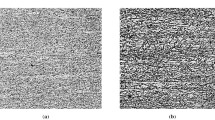Using correlation-regression analysis, the effects of structure and chemical composition on KCV impact strength anisotropy and difference in critical brittleness temperatures for longitudinal and transverse specimens of ferrite-pearlite and high-strength (ferrite + bainite) steels after thermomechanical rolling are studied. The significant effect of pearlite content and sulfide inclusions on impact strength anisotropy and difference in critical brittleness temperatures for longitudinal and transverse specimens of ferrite-pearlite steels is demonstrated. For high strength ferrite-bainite steels prepared using thermomechanical rolling technology the effect of carbon and sulfur on degree of embrittlement for transverse specimens is considered that also depends on the content of titanium carbonitride and Al2O3-based aluminum oxides.








Similar content being viewed by others
References
Yu. I. Matrosov, A. A. Litvinenko, and S. A. Golovanenko, Steel for Main Gas Pipelines [in Russian], Metallurgiya, Moscow (1989).
E. A, Goli-Oglu, L. I. Éfron, and Yu. D. Morozov, “Increase in the efficiency of thermomechanical treatment for microalloyed pipe steels,” Stal’, No. 2, 52–57 (2013).
V. M. Schastlivtsev, I. L. Yakovleva, N. A. Tereshehenko, V. V. Kurban, V. L. Kornilov, V. M. Solganik, and A. M. Pesin, “Features of the chemical composition and structure of low-carbon low-alloy pipe steels after controlled rolling,” Metal. Termobrab. Materialov, No. 5(635), 3–8 (2008).
A. R. Mishet’yan, I. P. Shabalov, O. N. Chevskaya, and G. A. Filippov, “Effect of structural state and temperature on crack growth and propagation resistance in pipe steels,” Metallurg, No. 12, 43–49 (2017).
Yu. D. Morozov, I. F. Pemov, E. A. Goli-Oglu, and L. V. Nizhel’skii, “Effect of rolled product cooling rate during controlled rolling on state of hot-worked austenite, final structure and mechanical properties of microalloyed steel. Part 1,” Metallurg, No. 2, 70–77 (2012).
A. V. Kushnarev, E. V. Shekhovtsov, E. S. Kapustina, S. A. Remigo, and I. V. Kostenko, “Development and assimilation of production technology for pipe steels of strength classes X80 and X70,” Stal’, No. 6, 71–74 (2008).
S. Yu. Nastich, S. V. Soya, A. A. Efimov, M. A. Molostov, and I. S. Vasil’ev, “Development of strip accelerated cooling regimes in order to form a ferrite-bainite microstructure for low-alloy steel X79 rolled product,” Stal’, No. 4, 5–57 (2012).
M. Yu. Matrosov, O. P. Talanov, I. V. Lyasotskii, and A. A. Kichkina, “Change in the structure and mechanical properties of thick sheet ferrite-bainite high-strength pipe steel under action of heat treatment,” Metalloved. Term. Obrab. Materialov, No. 5, 18–24 (2011).
A. G. Glebov, M. A. Shtremel’, and K. L. Kosyrev, “Region of the effect of impurities on impact strength of thick sheet steel,” Stal’, No. 5, 95–97 (2004).
V. M. Goritskii, M. A. Lushkin, O. V. Goritskii, and G. R. Shneiderov, “Effect of structural factors on anisotropic impact strength of rolled sheet of ferrite-pearlite steels,” Deformats. Rasrush. Materialov, No. 8, 16–21 (2014).
EN 100254: 2004. Hot Rolled Products of Structural Steel, Part 4: Technical Delivery Conditions for Thermomechanical Rolled Weldable Fine Grain Structural Steels.
V. M. Goritskii, and G. R. Shneiderov, and O. V. Goritskii, “Effect of impact strength anisotropy on brittle failure resistance properties of high-strength steels given thermomechanical rolling,” Metallurg, No. 5, 42–49 (2010).
V. M. Goritskii, G. R. Shneiderov, and I. A. Guseva, “Effect of chemical composition and structure on mechanical properties of low-alloy weldable steels after thermomechanical rolling,” Matallurg, No. 5, 49–55 (2016).
V.M. Goritskii, G. R. Shneiderov, and I.A. Guseva, “Effect of chemical composition and structure on mechanical properties of highstrength weldable steels,” Metallurg, No. 1, 18–24 (2019).
V. M. Goritskii, G. R. Shneiderov, and I.A. Guseva, “Study of impact strength anisotropy and tendency towards stratification of Strenx 650 MC and 700 MC steels after thermomechanical treatment,” Metallurg, No. 8, 29–38 (2018).
V. M. Goritskii, Use of Impact Strength Properties in Engineering Practice [in Russian], Metallurgizdat, Moscow (2016).
V.M. Goritskii, M. A. Lushkin, and O. V. Goritskii, “Impact strength anisotropy of structural steels with a ferrite-pearlite structure tested by the Charpy method,” Deformats. Razrush. Materialov, No. 3, 43–48 (2013).
Author information
Authors and Affiliations
Corresponding author
Additional information
Translated from Metallurg, Vol. 64, No. 11, pp. 36–45, November, 2020.
Rights and permissions
About this article
Cite this article
Goritskii, V.M., Goritskii, O.V. Effect of Structural Factors on Difference in Structural Steel Longitudinal and Transverse Impact Specimen Embrittlement after Controlled Rolling and Thermomechanical Treatment. Metallurgist 64, 1136–1149 (2021). https://doi.org/10.1007/s11015-021-01099-9
Received:
Published:
Issue Date:
DOI: https://doi.org/10.1007/s11015-021-01099-9




